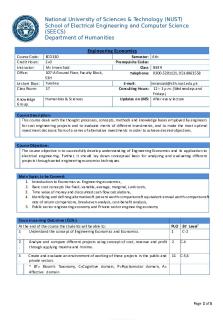EGM 241 Engineering Material I Course Content-2 PDF

| Title | EGM 241 Engineering Material I Course Content-2 |
|---|---|
| Author | Chris Kapenda |
| Course | Engineering materials |
| Institution | Mulungushi University |
| Pages | 3 |
| File Size | 75.8 KB |
| File Type | |
| Total Downloads | 17 |
| Total Views | 129 |
Summary
Course outline ...
Description
EGM 241
ENGINEERING MATERIALS I
Rationale: Engineering materials I is an introductory course to the broad field of material science and engineering and aims at introducing engineering students to different engineering materials, their properties, application and how they are used in different engineering disciplines. The course will introduce and familiarize students with important characteristics and properties used in commercial engineering materials and to establish how their physical and chemical behaviour can be related to crystalline and molecular structures. Course Objectives: On completion of the course, the student should be able to: 1. Demonstrate an understanding of the various mechanical, electrical, optical and thermal properties of materials. 2. Describe methods of determining mechanical properties. 3. Distinguish between various classes of steels and cast irons and their uses. 4. Demonstrate knowledge of the various techniques used to harden and strengthen metallic materials. 5. Describe the characteristics and uses of non-ferrous metals and alloys based on aluminium, copper and titanium. 6. Describe the characteristics and uses of non-metallic materials such as plastics, composites and ceramics. Course contents: 1. Classification of materials Metals, Ceramics, composites, polymers Advanced Materials: Semiconductors, Biomaterials, smart materials and Nanoenginered materials Modern Material needs 2. Bond theory Structure of materials: Primary bonds, secondary bonds, interatomic forces. Atomic structure, crystal structure. Atomic arrangement in crystals 3. Advanced materials and tools Smart materials, exhibiting ferroelectric, piezoelectric, optoelectric, semiconducting behaviour,
lasers and optical fibers, photoconductivity and superconductivity, nanomaterial, synthesis, properties and applications, biomaterials, super alloys, shape memory alloys. Materials characterization techniques such as, scanning electron microscopy, transmission electron microscopy, atomic force microscopy, scanning tunnelling microscopy, atomic absorption spectroscopy, differential scanning calorimetry. 4. Mechanical Properties Stress-strain diagrams of metallic, ceramic and polymeric materials, modulus of elasticity, yield strength, tensile strength, toughness, elongation, plastic deformation, viscoelasticity, hardness, impact strength, creep, fatigue, ductile and brittle fracture. 5. Thermal Properties Heat capacity, thermal conductivity, thermal expansion of materials. 6. Electrical Properties Concept of energy band diagram for materials - conductors, semiconductors and insulators, electrical conductivity effect of temperature on conductivity, intrinsic and extrinsic semiconductors, dielectric properties. Hall –effect 7. Optical properties Basic concepts: Reflection, refraction, absorption and transmission of electromagnetic radiation in solids. Light interactions with solids: opacity and translucency in insulators, lasers, optical fibres in communication. 8. Magnetic properties Origin of magnetism in metallic and ceramic materials, paramagnetism, diamagnetism, antiferro magnetism, ferromagnetism, ferrimagnetism, magnetic hysteresis. 9. Environmental degradation Forms of corrosion, corrosion of ceramic materials, Corrosion and oxidation of materials, corrosion prevention. Passivity Selection of materials: Service conditions. Strength to density and modulus to density ratios. Safety and reliability. Recycling and reuse of materials
Mode of Delivery: Lectures: 4 hours per week Laboratory: 3 hour session per week Assessment: Continuous Assessment (CA): 40% Assignments/Quizzes 5% Tests 20% Laboratory Experiments 5% Final Theory Examination: 60% Total: 100%
Recommended text book: 1. William D. Callister,Jr, Material Science and Engineering – An Introduction, 7th edition, John Wiley & Sons, 2007 Page 7 of 10
Supplementary readings: 1. M.F. Ashby & Jones D.R.H, Engineering Materials 1, Introduction to Properties, Applications and Design, 3rd Edition, 2005 2. M.F. Ashby & Jones D.R.H, Engineering Materials 2, Introduction to Microstructure, Processing, and Design, 3rd Edition, 2005...
Similar Free PDFs

Engineering Entire HSC Course
- 97 Pages

HK transport - course material
- 25 Pages

Engineering Eco. Course Outline
- 5 Pages

C936 PCE Course Material
- 14 Pages

EGM Homework 3
- 6 Pages

Legge 241:90 commentata
- 36 Pages

Transportation Engineering I Notes
- 59 Pages

PEAT 1 - PEAT course material
- 43 Pages

Riassunto legge 241 del 90
- 11 Pages

CY6151-Engineering Chemistry-I AND
- 10 Pages

Gd I Material H-05
- 1 Pages

Lec 3 - Engineering Ethics I
- 8 Pages

Gd I Material H-11
- 1 Pages
Popular Institutions
- Tinajero National High School - Annex
- Politeknik Caltex Riau
- Yokohama City University
- SGT University
- University of Al-Qadisiyah
- Divine Word College of Vigan
- Techniek College Rotterdam
- Universidade de Santiago
- Universiti Teknologi MARA Cawangan Johor Kampus Pasir Gudang
- Poltekkes Kemenkes Yogyakarta
- Baguio City National High School
- Colegio san marcos
- preparatoria uno
- Centro de Bachillerato Tecnológico Industrial y de Servicios No. 107
- Dalian Maritime University
- Quang Trung Secondary School
- Colegio Tecnológico en Informática
- Corporación Regional de Educación Superior
- Grupo CEDVA
- Dar Al Uloom University
- Centro de Estudios Preuniversitarios de la Universidad Nacional de Ingeniería
- 上智大学
- Aakash International School, Nuna Majara
- San Felipe Neri Catholic School
- Kang Chiao International School - New Taipei City
- Misamis Occidental National High School
- Institución Educativa Escuela Normal Juan Ladrilleros
- Kolehiyo ng Pantukan
- Batanes State College
- Instituto Continental
- Sekolah Menengah Kejuruan Kesehatan Kaltara (Tarakan)
- Colegio de La Inmaculada Concepcion - Cebu


